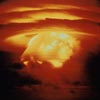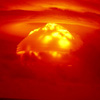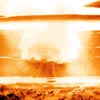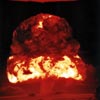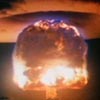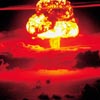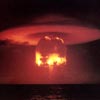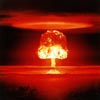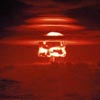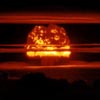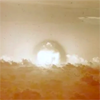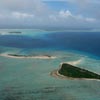 |
|
Operation Castle - 1954
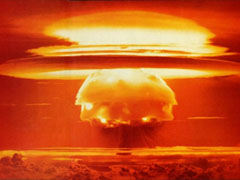
| |
Bravo 28/02/1954
|
Castle was the 9th US series, conducted by Joint Task Force Seven (JTF-7) at Bikini Atoll beginning in March 1954. A joint venture between the Atomic Energy Commission (AEC) and the Department of Defense (DoD), the ultimate objective of the operation was to test designs for an aircraft-deliverable thermonuclear weapon.
The test series encountered a number of technical difficulties: one device had a yield much lower than its predicted yield (a "fizzle"), while two other devices detonated with over twice their predicted yields. Public reaction to the tests and awareness of the effects of nuclear fallout has been attributed as being part of the motivation for the Partial Test Ban Treaty of 1963.
Operation Castle was intended to test "dry" lithium deuteride (LiD) as a thermonuclear fusion fuel. Solid at room temperature, LiD, if it worked, would be far more practical than the cryogenic liquid deuterium used in the Ivy Mike device two years before. The same basic principles would be used, but the fusion reactions would be different. Mike fused deuterium with deuterium, but the LiD devices would fuse deuterium with tritium. The tritium would be spontaneously produced during the explosion by irradiating the lithium with fast high energy neutrons. Operation Castle was charted to test four dry fuel designs, two wet bombs, and one smaller device. Approval for Operation Castle was communicated to JTF-7 by Major General Kenneth D. Nichols, General Manager of the AEC, on 21 January 1954.
Castle was organized into 7 experiments, all but one of which were to take place at Bikini Atoll. Below is the original test schedule as of February 1954.
Original Operation Castle Schedule
| Experiment |
Device |
Prototype |
Fuel |
Date |
Predicted Yield |
| Bravo |
Shrimp |
TX-21 |
40% Li-6 D (dry) |
01/03/1954 |
6 Mt |
| Union |
Alarm Clock |
EC-14 |
95% Li-6 D (dry) |
11/03/1954 |
3-4 Mt |
| Yankee |
Jughead |
TX/EC-16 |
Cryo H-3 (wet) |
22/03/1954 |
8 Mt |
| Echo |
Ramrod |
N/A |
Cryo H-3 (wet) |
29/03/1954 |
65-275 Kt |
| Nectar |
Zombie |
TX-15 |
Boosted Fission |
05/04/1954 |
1.8 Mt |
| Romeo |
Runt |
TX/EC-17A |
7.5% Li-6 D (natural) |
15/04/1954 |
4 Mt |
| Koon |
Morgenstern |
N/A |
7.6% Li-6 D (natural) |
22/04/1954 |
1 Mt |

| |
Bravo Shrimp device
|
Bravo and Union used lithium enriched in the Li-6 isotope, while Romeo and Koon were fueled with natural lithium (92% Li-7, 7.5% Li-6). The use of natural lithium was key as it was both inexpensive and abundant.
As a hedge, development of liquid deuterium weapons continued in parallel. Even though they were much less practical, due to the difficulties of dealing with the transport, handling, and storage of a cryogenic materials, the cold war arms race drove the demand for a viable fusion weapon. The Ramrod and Jughead devices were liquid fuel designs greatly reduced in size and weight from their Ivy Mike "Sausage" predecessor. The Jughead device was ultimately weaponized (TX/EC-16) and saw limited fielding in the inventory until the dry fuel weapons were common.
Liquid fueled "wet" weapons are logistically complex compared to "dry" ones. If stored unarmed, they require filling before deployment meaning delay and vulnerablity. On the other hand, if maintained fully-loaded, the the equipment required to maintain needs to be in constant operation, not to mention the issues of having a constantly armed nuclear weapon. The same heavy cyrogenic equipment was still required aboad the delivery aircraft, affecting range and bombload. The TX-16 vented explosive hydrogen gas at a rate of 50 liters an hour, in effect making the bomber that carried it a mini Hindenburg.
Nectar was not a fusion weapon in the same sense as the rest of the Castle series. Even though it used dry lithium fuel for fission boosting, the principal reaction material in the second stage was uranium and plutonium. Similar to the Teller-Ulam configuration, a fission device was used to create high temperatures and pressures in order to compress a second fissionable mass that would have otherwise been too large to sustain an efficient reaction if it were triggered with conventional explosives. This experiment was intended to develop intermediate yield weapons for expanding the inventory (around 1-2 Mt vs. 4-8).
It should be noted that many "fusion" or "thermonuclear" weapons still generate much or even most of their yields from fission. Although the U-238 isotope of uranium (i.e., "natural" or "depleted" uranium) will not sustain a chain reaction, it still fissions when irradiated by the intense fast neutron flux of a fusion explosion. Because U-238 is plentiful and has no critical mass, it can be added in almost unlimited quantities as a "tamper" around a fusion bomb, helping to contain the fusion reaction and contributing its own fission energy. Fission of the U-238 tamper contributed 77% (8 megatons) to the yield of the 10.4 Mt Ivy Mike explosion.
Bravo
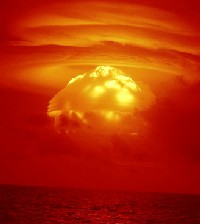
| |
Castle Bravo
|
The most notable event of Operation Castle was the Bravo test. The dry fuel for Bravo was 40% Li-6 and 60% Li-7. Only the Li-6 was expected to breed tritium for the deuterium-tritium fusion reaction; the Li-7 was expected to be inert. Yet J. Carson Mark, head of the Los Alamos Theoretical Design Division, had speculated that 'Bravo' could "go big", estimating that the device could produce an explosive yield as much as 20% more than had been originally calculated. The Li-7 component turned out to be an excellent source of tritium through a previously unquantified reaction known as the "tritium bonus". Bravo exceeded expectations by 250%, yielding a massive 15 Mt. Bravo remains to this day the largest atmospheric detonation ever conducted by the United States, and the seventh largest ever detonated.
Because Bravo greatly exceeded its expected yield, JTF-7 was caught unprepared. Much of the permanent infrastructure on Bikini Atoll was heavily damaged. The intense thermal pulse ignited fires at a distance of 20 nautical miles (37 km) on the island of Eneu. The ensuing fallout contaminated the entire atoll, so much so that it could not be approached by JTF-7 for 24 hours after the test, and even then access was limited. As the fallout spread downwind to the east, more atolls were contaminated by radioactive ash from the incinerated underwater coral banks.
Although the atolls were evacuated soon after the test, 239 Marshallese on the Utirik, Rongelap, and Ailinginae Atolls were subjected to significant levels of radiation. 28 Americans stationed on the Rongerik Atoll were also exposed. Additionally, 23 Japanese fishermen aboard Lucky Dragon No. 5 were also exposed to high levels of radiation. They suffered symptoms of radiation poisoning, and one crew member died in September 1954. This incident created an international uproar, and a diplomatic crisis with Japan. After this test the exclusion zone around the Castle tests was increased to 1.4 million square kilometers, a circle 1,367 kilometers in diameter. For comparison this is equal to about 1% of the entire Earth's land area.
The heavy contamination and extensive damage from Bravo significantly delayed the rest of the series. The post Bravo schedule was revised on 14 April 1954. The Romeo and Koon tests were complete by the time of this revision. The Echo test was canceled due to the liquid fuel design becoming obsolete with the success of dry-fueled Bravo. The Yankee device was similarly considered obsolete and was conducted using a Runt II device (similar to the 'Union' device) hastily completed at Los Alamos and flown to Bikini. With this revision, both of the wet fuel devices were removed from the test schedule.
As the operation continued, the increased yields and fallout caused test locations to be re-evaluated. While the majority of the tests were planned for barges near the sand spit of Iroij, some were moved to the Bravo and Union craters. Additionally, Nectar was moved from Bikini Atoll to the Ivy Mike crater at Enewitok for expediency since Bikini was still heavily contaminated from the previous tests.
Outcome
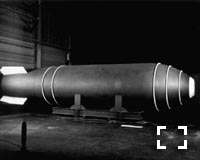
| |
Mk-17 bomb
|
The test series came to an end on the 14th of May 1954 with the detonation of shot Nectar.
Operation Castle was an unqualified success for the implementation of dry fuel devices. The Bravo design was quickly weaponized and is suspected to be the progenitor of the Mk-21 gravity bomb. The Mk-21 design project began on 26 March 1954 (just three weeks after Bravo) with production of 275 weapons beginning in the fall of 1955. Romeo, relying on natural lithium, was rapidly turned into the Mk-17 bomb, the US first deployable H bomb , and was available to strategic forces as an Emergency Capability by late summer of 1954. Most of the Castle dry fuel devices eventually appeared in the inventory and ultimately grandfathered the majority of thermonuclear configurations.
In contrast, the Livermore-designed Koon design was a failure. Using natural lithium and a heavily modified configuration, the test produced only 110 Kt of an expected 1.5 Mt. Of this 100 kt was from fission (almost entirely due to the primary), only 10 kt of energy was contributed by fusion reactions.While engineers at the Radiation Laboratory had hoped it would lead to a promising new field of weapons, it was eventually determined that the design allowed premature heating of the lithium fuel, thereby disrupting the delicate fusion conditions. The failure of this dry fueled design also led to the cancellation of the test for its cryogenic sister device - the Ramrod.
An interesting phenomena occured during shots Romeo and Nectar, where a small blob can be seen seperating from the top pf the initial fireball.

| - DNA 6035F - Defense Nuclear Agency report - Castle
|
|
|
|
 |










